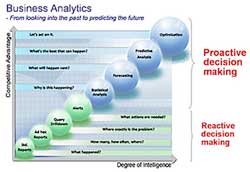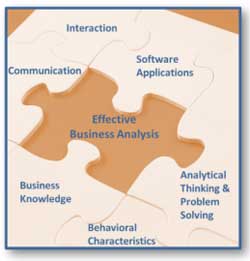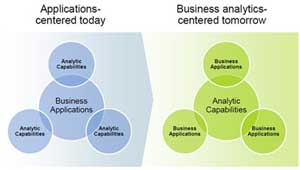Business Analytics: Technology linked to Management
Sakshi Education

Introduction:
A study of data through various statistical and operations analysis, or, a combination of skills, technologies, applications and processes used by organizations to formulate predictive models, applications of optimization techniques and communicating these results with customers, business partners and colleague executives is known as Business Analytics. Popularly abbreviated as BA, it is used to gain insight in to the organizations business capabilities based on data and statistics to herd business planning. Implemented in all departments from sales to product development to customer service, BA is used to evaluate organization-wide operations.
The BA solutions typically uses data, statistical and quantitative analysis and fact based data to measure the organizations’ past performance and convoy the business planning.
What is BA?
 There was a time when business analysis was considered to be done only by top men of the organization. Even when I was teaching for undergraduates who were enrolled in Business Analytics and Optimization course, parents were bewildered on why a management course was taught for a computer science degree. A completely wrong notion prevailed in student’s ideology on what a Business Analyst does. This article nullifies the dogma that BA is only for the elite individuals with a Master’s in Business Administration. As a matter of fact, data is much better analyzed by persons with background in mathematics, physics and statistics.
There was a time when business analysis was considered to be done only by top men of the organization. Even when I was teaching for undergraduates who were enrolled in Business Analytics and Optimization course, parents were bewildered on why a management course was taught for a computer science degree. A completely wrong notion prevailed in student’s ideology on what a Business Analyst does. This article nullifies the dogma that BA is only for the elite individuals with a Master’s in Business Administration. As a matter of fact, data is much better analyzed by persons with background in mathematics, physics and statistics.
For data driven companies, data itself is a huge corporate asset and leverage it for competitive advantage. To successfully implement business analytics in an organization, it depends mainly on data quality, skilled analysts who grasp the technologies and the business and the entire organization commitment to data driven decision making.
The following are various uses of BA:
An analysis methodology is selected and data is acquired to support the analysis after the business goal of the analysis is determined. Data is acquired from one or more business systems, cleansing, and integration into a single repository such as a data warehouse or a data mart. A smaller sample of data is chosen and then analysis is performed. Spreadsheets with statistical functions to complex data mining and predictive modeling applications are few of the analytic tools. Every time a new question is asked, whenever a new pattern and its relationship in the data are uncovered, and the analytic process iterates until the business goal is met. Typically a database is used to score records that are used to optimize real-time decisions within applications and business processes during deployment of predictive models. To make tactical decisions during any unforeseen events, BA supports in decision making and in many cases it is automated to support real-time responses.
Only from the last decade or so did the word analytics came into foreground, thanks to the proliferation of the internet and information technology that fueled the relevance of analytics in the current age. A fusion of data, statistical analysis, information technology, quantitative methods and computer-based models into one is termed as analytics that provides decision makers all possible sequence of events to make a well thought and researched decision. The other advantage behind using a computer-based model is that the decision makers are able to witness the performance of decisions under various scenarios before really implementing them.
Apart from getting a clear picture on business analysis, we also now have much wider perspective of the key areas that provide context to the overall discipline. These are:
Importance of Business Analysis:
In lieu with the definition discussed earlier, business analysis helps the stakeholders realize and achieve a shared understanding of the organization’s needs. The shared understanding will put the team in a position to make legitimate recommendations for specific needs whilst putting the organization in a position to move ahead with all the recommendations that best meets those needs. Business analysis helps the organization to create a map for moving from current state where the needs are unmet to the desired state where needs are met by having a shared understanding of needs, legitimate recommendations and agreement to move ahead with a certain set of recommendations. As the team navigates from origin to destination, the map helps to keep the stakeholders informed about the progress.
The practitioners have to earn the trusted advisor status if he is either internal or external consultant. It is very important to have that trust as they will be working very closely with the organization’s management team and they usually don’t have to work into a project, rather they are requested to get involved.
Responsibilities of a business analysis practitioner:
The knowledge areas that are listed and fully described in the Business Analysis Body of Knowledge (BABOK 2.0, listed as a reference and available on International Institute of Business Analysis (IIBA) website) are briefly addressed below:
Depending on the complexity of an initiative, structure of the organization and other factors, it is important to bear in mind, these responsibilities may not be owned by a single practitioner. A practitioner must understand that he too is a stakeholder on every project in which he is involved like participating in routine meetings and taking notes apart from contemplating on what and why is he doing it.
How does a practitioner accomplish the responsibilities?
There are wide variety of techniques available for the practitioner to accomplish the responsibilities addressed by each knowledge areas that are also listed in BABOK 2.0. Although, the BA community, apart from demonstrating process modeling to user stories that are brainstormed, has to realize the importance of acquiring and maintaining a balanced set of techniques in his/her BA arsenal as well as be efficient in choosing the best technique for any given scenario.
Competencies of a practitioner:
 A BA practitioner can accomplish the responsibilities of business analysis based on his underlying competencies. To support effective business analysis, all these underlying competencies have to fit together like pieces of a puzzle.
A BA practitioner can accomplish the responsibilities of business analysis based on his underlying competencies. To support effective business analysis, all these underlying competencies have to fit together like pieces of a puzzle.
As highlighted earlier, the practitioner should upgrade his skills and maintain them in order to be effective than others.
Key challenges faced by a practitioner:
There are challenges that arise for any practitioner in any discipline. The following are the key challenges faced by a Business Analysis practitioner:
Strategies for overcoming key challenges:
Here are some important measures and strategies to overcome any key challenge that a practitioner might face (need not be every single challenge):
Evolution of Business Analytics:
The history of business analytics starts way long which has evolved with the availability of better and latest technologies. During World War II, it had its roots in operation research which was an analytical way of looking data to conduct military operations. This technique slowly, over the period of time, started getting utilized for business. The future of Business Analysis is well depicted in the following figure.
Scope of this subject in future:
 We’ve come to a junction where understanding the fact that business analysis matured over the years and goes beyond requirement analysis is purely justified. We are aware of the case that business analysis is about delivering value to clients by facilitating them to make right decisions to meet the specific needs. We have also come to know that there will be challenges faced by the practitioner and the organization they support with the application of business analysis but, we have come far across in this discipline to identify and apply key strategies that will help mitigate those challenges.
We’ve come to a junction where understanding the fact that business analysis matured over the years and goes beyond requirement analysis is purely justified. We are aware of the case that business analysis is about delivering value to clients by facilitating them to make right decisions to meet the specific needs. We have also come to know that there will be challenges faced by the practitioner and the organization they support with the application of business analysis but, we have come far across in this discipline to identify and apply key strategies that will help mitigate those challenges.
Understanding how business analysis grew over several years and taking advantage of that is totally appropriate and at the same time, we must be mindful of is that this discipline continues to progress even as development in general progresses. As the discipline matures, we as practitioners must evolve in kind.
Read… Global Careers with Business Analytics
https://www.sakshieducation.com/CareerEngStory.aspx?nid=57570&cid=2&sid=13&chid=924&tid=0
Institutions offering courses:
There are several institutions in India and abroad that offer courses in Business Analytics. There are reputed institutions like University of Petroleum and Energy Studies, Dehradun, that offer a fully integrated Computer Science Bachelor’s degree with a specialization in Business Analytics and Optimization. Top B-Schools provide various certification courses in Business Analytics with varied experience levels ranging from MBA to Executive MBA to a one year Executive Certification courses.
Please look into the references for further details.
Career Prospects:
Every major sector in this world ranging from Banking, Financial Services and Institutions to Healthcare, Electrical and Electronic to E-Commerce, Sports and Entertainment to Space analytics, IT and ITES etc., has a requirement of Business Analytics. Please look into the references list for further details.
References:
A study of data through various statistical and operations analysis, or, a combination of skills, technologies, applications and processes used by organizations to formulate predictive models, applications of optimization techniques and communicating these results with customers, business partners and colleague executives is known as Business Analytics. Popularly abbreviated as BA, it is used to gain insight in to the organizations business capabilities based on data and statistics to herd business planning. Implemented in all departments from sales to product development to customer service, BA is used to evaluate organization-wide operations.
The BA solutions typically uses data, statistical and quantitative analysis and fact based data to measure the organizations’ past performance and convoy the business planning.
What is BA?
 There was a time when business analysis was considered to be done only by top men of the organization. Even when I was teaching for undergraduates who were enrolled in Business Analytics and Optimization course, parents were bewildered on why a management course was taught for a computer science degree. A completely wrong notion prevailed in student’s ideology on what a Business Analyst does. This article nullifies the dogma that BA is only for the elite individuals with a Master’s in Business Administration. As a matter of fact, data is much better analyzed by persons with background in mathematics, physics and statistics.
There was a time when business analysis was considered to be done only by top men of the organization. Even when I was teaching for undergraduates who were enrolled in Business Analytics and Optimization course, parents were bewildered on why a management course was taught for a computer science degree. A completely wrong notion prevailed in student’s ideology on what a Business Analyst does. This article nullifies the dogma that BA is only for the elite individuals with a Master’s in Business Administration. As a matter of fact, data is much better analyzed by persons with background in mathematics, physics and statistics. For data driven companies, data itself is a huge corporate asset and leverage it for competitive advantage. To successfully implement business analytics in an organization, it depends mainly on data quality, skilled analysts who grasp the technologies and the business and the entire organization commitment to data driven decision making.
The following are various uses of BA:
- Exploring data to find new patterns and relationships (data mining)
- Explaining why a certain result occurred (statistical analysis, quantitative analysis)
- Experimenting to test previous decisions (A/B testing, multivariate testing)
- Forecasting future results (predictive modeling, predictive analytics)
An analysis methodology is selected and data is acquired to support the analysis after the business goal of the analysis is determined. Data is acquired from one or more business systems, cleansing, and integration into a single repository such as a data warehouse or a data mart. A smaller sample of data is chosen and then analysis is performed. Spreadsheets with statistical functions to complex data mining and predictive modeling applications are few of the analytic tools. Every time a new question is asked, whenever a new pattern and its relationship in the data are uncovered, and the analytic process iterates until the business goal is met. Typically a database is used to score records that are used to optimize real-time decisions within applications and business processes during deployment of predictive models. To make tactical decisions during any unforeseen events, BA supports in decision making and in many cases it is automated to support real-time responses.
Only from the last decade or so did the word analytics came into foreground, thanks to the proliferation of the internet and information technology that fueled the relevance of analytics in the current age. A fusion of data, statistical analysis, information technology, quantitative methods and computer-based models into one is termed as analytics that provides decision makers all possible sequence of events to make a well thought and researched decision. The other advantage behind using a computer-based model is that the decision makers are able to witness the performance of decisions under various scenarios before really implementing them.
Apart from getting a clear picture on business analysis, we also now have much wider perspective of the key areas that provide context to the overall discipline. These are:
- Importance of business analysis
- Responsibilities of business analysis practitioners
- How does a practitioner accomplish the responsibilities?
- Competencies of the practitioner
- Key challenges faced by a practitioner
- Strategies for overcoming key challenges
Importance of Business Analysis:
In lieu with the definition discussed earlier, business analysis helps the stakeholders realize and achieve a shared understanding of the organization’s needs. The shared understanding will put the team in a position to make legitimate recommendations for specific needs whilst putting the organization in a position to move ahead with all the recommendations that best meets those needs. Business analysis helps the organization to create a map for moving from current state where the needs are unmet to the desired state where needs are met by having a shared understanding of needs, legitimate recommendations and agreement to move ahead with a certain set of recommendations. As the team navigates from origin to destination, the map helps to keep the stakeholders informed about the progress.
The practitioners have to earn the trusted advisor status if he is either internal or external consultant. It is very important to have that trust as they will be working very closely with the organization’s management team and they usually don’t have to work into a project, rather they are requested to get involved.
Responsibilities of a business analysis practitioner:
The knowledge areas that are listed and fully described in the Business Analysis Body of Knowledge (BABOK 2.0, listed as a reference and available on International Institute of Business Analysis (IIBA) website) are briefly addressed below:
- Business Analysis Planning and Monitoring
- Elicitation
- Requirements Management and Communication
- Enterprise Analysis
- Requirements Analysis
- Solution Assessment and Validation
Depending on the complexity of an initiative, structure of the organization and other factors, it is important to bear in mind, these responsibilities may not be owned by a single practitioner. A practitioner must understand that he too is a stakeholder on every project in which he is involved like participating in routine meetings and taking notes apart from contemplating on what and why is he doing it.
How does a practitioner accomplish the responsibilities?
There are wide variety of techniques available for the practitioner to accomplish the responsibilities addressed by each knowledge areas that are also listed in BABOK 2.0. Although, the BA community, apart from demonstrating process modeling to user stories that are brainstormed, has to realize the importance of acquiring and maintaining a balanced set of techniques in his/her BA arsenal as well as be efficient in choosing the best technique for any given scenario.
Competencies of a practitioner:
 A BA practitioner can accomplish the responsibilities of business analysis based on his underlying competencies. To support effective business analysis, all these underlying competencies have to fit together like pieces of a puzzle.
A BA practitioner can accomplish the responsibilities of business analysis based on his underlying competencies. To support effective business analysis, all these underlying competencies have to fit together like pieces of a puzzle. As highlighted earlier, the practitioner should upgrade his skills and maintain them in order to be effective than others.
Key challenges faced by a practitioner:
There are challenges that arise for any practitioner in any discipline. The following are the key challenges faced by a Business Analysis practitioner:
- Poor understanding of the business analysis role and value it brings – lack of understanding of the business analyst role by the practitioner and the value brought by him to the organization is a very big risk for the practitioner and will mitigate his ability to meet the organization’s needs.
- Lack of individual passion for business analysis – business analysis not only requires capabilities in various knowledge areas but also few underlying competencies. Without the practitioner being passionate about what he does, he might not be productive and be a part of the lengthy discussions, effective research and decision analysis.
- Gaps in individual skills and knowledge – even if the practitioner is passionate about fulfilling the role, there may be few gaps in the practitioner’s individual skills and knowledge set. The organization cannot take a proactive approach to assessing and addressing the gaps amidst ongoing efforts without necessary expertise.
- Poor understanding of the development lifecycle and approach – failure to have a clear notion on the development lifecycle, impedes the practitioner’s ability to provide results that meets the organization’s needs.
- Insufficient organizational support for the business analysis role – key point is here is that the organization has to understand and support the role of business analysis. Lack of organizational support will put the practitioner in a situation where the needs of an organization are difficult to meet.
Strategies for overcoming key challenges:
Here are some important measures and strategies to overcome any key challenge that a practitioner might face (need not be every single challenge):
- Support practitioners in obtaining and maintaining knowledge and credentials from external sources
- Establish internal business analysis forums and/or centers of excellence.
- Share stakeholder-appropriate views of business analysis throughout the organization.
- Support a practitioner in changing roles, if he cannot discover (or rediscover) his passion for business analysis.
- Publish the successes of properly applied business analysis.
- Support practitioners in obtaining and maintaining general development knowledge and experience.
- Support the regular assessment of practitioner knowledge and competency, according to industry standards and per organizational gradations.
Evolution of Business Analytics:
The history of business analytics starts way long which has evolved with the availability of better and latest technologies. During World War II, it had its roots in operation research which was an analytical way of looking data to conduct military operations. This technique slowly, over the period of time, started getting utilized for business. The future of Business Analysis is well depicted in the following figure.
Scope of this subject in future:
 We’ve come to a junction where understanding the fact that business analysis matured over the years and goes beyond requirement analysis is purely justified. We are aware of the case that business analysis is about delivering value to clients by facilitating them to make right decisions to meet the specific needs. We have also come to know that there will be challenges faced by the practitioner and the organization they support with the application of business analysis but, we have come far across in this discipline to identify and apply key strategies that will help mitigate those challenges.
We’ve come to a junction where understanding the fact that business analysis matured over the years and goes beyond requirement analysis is purely justified. We are aware of the case that business analysis is about delivering value to clients by facilitating them to make right decisions to meet the specific needs. We have also come to know that there will be challenges faced by the practitioner and the organization they support with the application of business analysis but, we have come far across in this discipline to identify and apply key strategies that will help mitigate those challenges. Understanding how business analysis grew over several years and taking advantage of that is totally appropriate and at the same time, we must be mindful of is that this discipline continues to progress even as development in general progresses. As the discipline matures, we as practitioners must evolve in kind.
Read… Global Careers with Business Analytics
https://www.sakshieducation.com/CareerEngStory.aspx?nid=57570&cid=2&sid=13&chid=924&tid=0
Institutions offering courses:
There are several institutions in India and abroad that offer courses in Business Analytics. There are reputed institutions like University of Petroleum and Energy Studies, Dehradun, that offer a fully integrated Computer Science Bachelor’s degree with a specialization in Business Analytics and Optimization. Top B-Schools provide various certification courses in Business Analytics with varied experience levels ranging from MBA to Executive MBA to a one year Executive Certification courses.
Please look into the references for further details.
Career Prospects:
Every major sector in this world ranging from Banking, Financial Services and Institutions to Healthcare, Electrical and Electronic to E-Commerce, Sports and Entertainment to Space analytics, IT and ITES etc., has a requirement of Business Analytics. Please look into the references list for further details.
References:
- https://www.stern.nyu.edu/programs-admissions/global-degrees/business-analytics/program-overview/what-business-analytics
- https://www.webopedia.com/TERM/B/business_analytics.html
- https://searchbusinessanalytics.techtarget.com/definition/business-analytics-BA
- https://www.managementstudyguide.com/business-analytics.htm
- https://www.cardinalsolutions.com/cardinal/blog/requirements/2013/02/the_scope_and_value.html
- https://www.upes.ac.in/btech-computer-science-engineering-with-specialization-in-business-analytics-and-optimization
- https://www.isb.edu/certificate-programme-in-business-analytics
- https://programslive.iimcal.ac.in/executive-program-business-analytics-epba
- https://analyticsindiamag.com/top-6-analytics-courses-in-india/
- https://www.bridging-the-gap.com/42-reasons-to-consider-starting-a-business-analyst-career/
- https://in.linkedin.com/job/business-analyst-jobs/
Published date : 06 Oct 2014 05:19PM



















